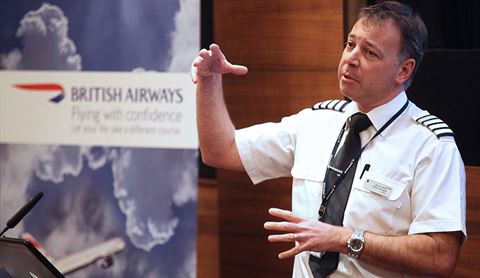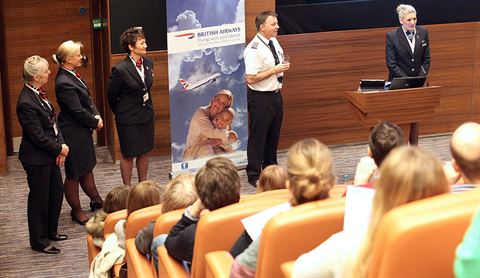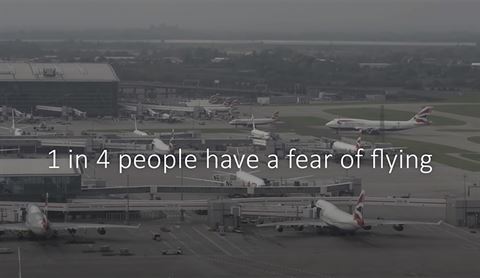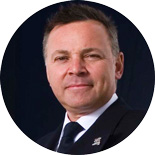THE INSIDE TRACK • September 2020
How do you… help a nervous flyer?
At a time when everyone’s a bit worried about hopping on board, we turn to Captain Steve Allright who, for nearly three decades, has helped more than 50,000 people by pioneering and presenting the Flying with Confidence course. Today, it has a 98 per cent success rate, but how did it all get started? And what happens to that two per cent? We ask the man himself…
How did you get involved with the Flying with Confidence course?
I joined British Airways back in 1990 on the 757, which means I’m now clocking in 30 years (!) of service and roughly 17,000 flying hours. Two years after I joined, I got involved in the Flight Crew Customer First Team (a team of pilots who volunteer to go out and educate the public), which steered me towards what was then called our ‘Fear of Flying’ course, set up six years prior by the two pilots who trained me, Peter Hughes and Doug Ord. In 2010, Peter and I led the rebrand on the course, and so it became Flying with Confidence.
Tell us a bit about the course itself
It’s a one-day course, split into three parts: pilot presentations (theory of flight, turbulence, etc), then the psychologist portion, talking all things fear and anxiety, then finally a 45-minute flight to put everything learned into practice. We have a bespoke crew on the flight, including multiple pilots, to talk the participants through what they’re experiencing. It’s truly a life-changing day and very emotional. A lot of people start off crying with anxiety and by the end are hugging each other in celebration (well… we used to hug!)

Top of the class: Captain Steve has three decades’ experience teaching the Flying with Confidence course
Do you just run the one course?
We actually have quite a few courses, which we’ve tailored in the same way British Airways tiers the cabins. Our primary course is the one I’ve just described. The rest are:
Primary Plus course: This is our World Traveller Plus product. It’s run on the same day as the primary course and involves the same flight at the end, but it’s capped at ten people, with a separate pilot and a separate psychologist for a bit more of a personal touch.
Premium course: This is our Club product for those who are willing to pay for a little more TLC. It’s capped at four people, who get two hours with the pilot and two with the psychologist, before all six of us head off on a scheduled British Airways flight to Edinburgh and back. On the way there, two of the participants will sit with me, and two with the psychologist. Then we switch on the way back.
“On our courses for children, the most important thing is taking them to Heathrow, letting them see the staff happily go to work like in any other job.”
Private course: This is our First class course. It’s the same as the Premium Course (including the return journey to Edinburgh), except it’s a completely one-to-one, bespoke experience.
Children and teens: We also run courses for children and teenagers, believe it or not. The one for seven-to-11-year-olds is always well subscribed, and some of them are in a really bad way. We don’t take them flying, but we do workshops and games. The most important thing is taking them to Heathrow and letting them see the staff happily go off to work like in any other job. Then my wife, who has been a secondary school counsellor for ten years, runs the teenage course, a day with more games and chocolate-based bribes – that kind of thing.

A small team of British Airways personnel makes the day a success
What is the number one cause of anxiety in passengers?
Turbulence, always. We always run a very big session on it and emphasise that it’s a perfectly normal part of flying. I’d say claustrophobia is the runner-up, so the psychologist covers off that one as thoroughly as possible.
Do you ever get participants who can’t board that final flight?
We’re very proud of our 98 per cent success rate, but there is that 2 per cent we can’t convince. There’s always a pilot on hand to look after those who can’t quite manage to board and I used to worry that these people would see it as a failure. Then one refusenik told me that, on the contrary, she was delighted with her progress. She’d spent the past 25 years avoiding even driving past airports, and today she’d actually gone inside one, got air side, sat in the seat. It’s not a failure – just too much for one day. For these people, we offer a flight-only option, so they can come back and try again.
Flying with Confidence - Ronnie's story
Watch the video below

What are your top ten tips for nervous flyers?
1) Remember that turbulence is uncomfortable but never dangerous. It is a perfectly normal part of flying caused by nature.
2) Learn to control your breathing. When you feel anxious, take a long, deep breath in, then hold your breath, followed by a long, deep breath out. Continue long, deep breathing.
3) Combine the deep breath in with a muscle contraction. Clenching your buttocks is most effective, as it overrides other nervous signals going up and down your spinal cord.
4) Aircraft like to be in the air. They are designed to be in the air. Pilots and cabin crew like to be in the air, too. It is a very normal and safe environment for them to be in.
“Pilots undergo a rigorous selection procedure and are some of the most highly trained and tested professionals on earth.”
5) Think about an eagle soaring through the air with its wings. They don’t flap, do they? They stay still and still stay in the air. Wings produce lift, which is what airplanes do, even without engines. A commercial aircraft flying at 30,000ft can glide for 100 miles even if all the engines fail, which is extraordinarily rare.
6) Pilots undergo a rigorous selection procedure and are some of the most highly trained and tested professionals on earth. They are subjected to simulator tests every six months.
7) Split a long flight up into half-hour sections. Go with a plan of things to do. Write a letter, watch a film, read a book, eat a meal.
8) Many people would happily go on a funfair ride rather than an aircraft, when actually the level of maintenance and security checks on the latter is far superior, almost unparalleled. Commercial aircraft are checked before every flight by pilots and engineers, and maintenance is conducted at regular intervals by licensed engineers.
9) Air traffic controllers are trained and licensed professionals operating under a very strict set of rules. All pilots have to abide by the rules of the air.
10) Visualise yourself stepping off the aircraft into the arms of loved ones, or into a lovely warm climate, or into a successful business meeting.
More from previous issues

My Club: the baker to the stars
Entrepreneur and baking goddess Mich Turner tells The Club what she’s been working on and reveals her future travel plans

Travel quiz: do you know your aviation lingo?
Consider yourself a bit of an AV whizz? Put your knowledge to the test with our cryptic quiz

Stylish sleeps: the hotels for your next getaway
Find out where the world’s leading architects lay their visionary heads with our round-up of some of their favourite hotels

The eStore’s guide to the Caribbean
If you’re yearning for winter sun and those barefoot island vibes, get in the mood by creating some Caribbean colour at home
